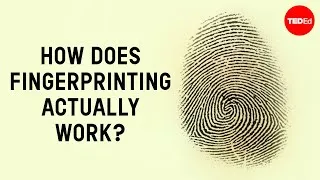请双击下面的英文字幕来播放视频。
00:00
Translator: Timothy Covell
Reviewer: Morton Bast
0
0
7000
翻译人员: xuan wang
校对人员: Qiang He
00:12
This is me building a prototype
1
12346
2770
这是我正在做一个模型
00:15
for six hours straight.
2
15116
2920
足足花了6个小时,
00:18
This is slave labor to my own project.
3
18036
3921
完全是苦力活。
00:21
This is what the DIY and maker movements really look like.
4
21957
4990
这就是所谓的自己动手做和自造者运动。
00:26
And this is an analogy for today's construction and manufacturing world
5
26947
4766
这也是今日全球建筑和制造业的缩影:
00:31
with brute-force assembly techniques.
6
31713
2788
到处可见费尽蛮力的组装技术。
00:34
And this is exactly why I started studying
7
34501
2834
这也是我为什么开始研究
00:37
how to program physical materials to build themselves.
8
37335
4269
如何让物理材料根据特定程序来组装自己。
00:41
But there is another world.
9
41604
1760
但是,还有另外一个世界。
00:43
Today at the micro- and nanoscales,
10
43364
1995
如今在微观纳米级上,
00:45
there's an unprecedented revolution happening.
11
45359
2751
正在发生一场空前的革命。
00:48
And this is the ability to program physical and biological materials
12
48110
4132
这就是通过编程使物理和生物材料
00:52
to change shape, change properties
13
52242
2724
改变形状、改变属性的能力,
00:54
and even compute outside of silicon-based matter.
14
54966
2986
它的应用范围甚至超过了硅基物质。
00:57
There's even a software called cadnano
15
57952
2507
甚至已经有了一个叫cadnano的软件
01:00
that allows us to design three-dimensional shapes
16
60459
2783
我们可以用它来设计各种三維物体。
01:03
like nano robots or drug delivery systems
17
63242
3084
比如纳米机器人或者药物传输系统,
01:06
and use DNA to self-assemble those functional structures.
18
66326
4303
以及利用DNA自我组装各种功能结构。
01:10
But if we look at the human scale,
19
70629
2073
但是,如果我们再看宏观的人类社会生活,
01:12
there's massive problems that aren't being addressed
20
72702
3056
还有很多问题没有被
01:15
by those nanoscale technologies.
21
75758
2368
这些纳米级技术解决。
01:18
If we look at construction and manufacturing,
22
78126
2099
如果我们看看建筑业和制造业,
01:20
there's major inefficiencies, energy consumption
23
80225
4193
有很多效率严重低下的地方,比如能源消耗
01:24
and excessive labor techniques.
24
84418
2327
和过多的人工技能需求。
01:26
In infrastructure, let's just take one example.
25
86745
2505
在基础设施方面,我们举个例子,
01:29
Take piping.
26
89250
1483
比如说铺设管道。
01:30
In water pipes, we have fixed-capacity water pipes
27
90733
3725
水管,我们的水管都是固定容积,
01:34
that have fixed flow rates, except for expensive pumps and valves.
28
94458
4459
固定流量的,除了昂贵的水泵和水阀以外。
01:38
We bury them in the ground.
29
98917
1291
我们把它们埋在地底下,
01:40
If anything changes -- if the environment changes,
30
100208
2621
如果有任何变动 - 比如环境变化,
01:42
the ground moves, or demand changes --
31
102829
2637
地基移动或者需求改变-
01:45
we have to start from scratch and take them out and replace them.
32
105466
4250
我们就得从头再来, 把它们挖出来再换新的。
01:49
So I'd like to propose that we can combine those two worlds,
33
109716
3368
所以我建议把这两个世界结合起来,
01:53
that we can combine the world of the nanoscale programmable adaptive materials
34
113084
5171
把纳米级上可程序化、能自我调节的材料
01:58
and the built environment.
35
118255
1677
和生产环境结合起来。
01:59
And I don't mean automated machines.
36
119932
2186
我的意思不是自动化设备。
02:02
I don't just mean smart machines that replace humans.
37
122118
2459
我指的也不仅仅是让智能机器替代人类劳动,
02:04
But I mean programmable materials that build themselves.
38
124577
3884
而是那些可以可程序化的材料实现自我组装。
02:08
And that's called self-assembly,
39
128461
2056
这就叫做自我组装,
02:10
which is a process by which disordered parts build an ordered structure
40
130517
4517
一种把各个无序的零部件组成一个有序的结构的过程,
02:15
through only local interaction.
41
135034
2493
这一切都只通过材料自身的相互作用来完成。
02:17
So what do we need if we want to do this at the human scale?
42
137527
3175
那么要把它应用于人类社会生活,我们又需要些什么呢?
02:20
We need a few simple ingredients.
43
140702
1975
我们只需要一些简单的条件,
02:22
The first ingredient is materials and geometry,
44
142677
2839
第一个就是材料和几何形状,
02:25
and that needs to be tightly coupled with the energy source.
45
145516
3469
这需要和能源材料紧密结合起来。
02:28
And you can use passive energy --
46
148985
1658
我们可以用被动式能源 -
02:30
so heat, shaking, pneumatics, gravity, magnetics.
47
150643
4684
比如热力、抖动、气压、重力、磁力。
02:35
And then you need smartly designed interactions.
48
155327
3075
同时我们也需要设计得非常巧妙的交互方式。
02:38
And those interactions allow for error correction,
49
158402
2133
而且这些交互方式可以纠错,
02:40
and they allow the shapes to go from one state to another state.
50
160535
4000
可以让已成型的物体改变状态。
02:44
So now I'm going to show you a number of projects that we've built,
51
164535
3232
我现在要为大家展示我们已经做好的一些项目,
02:47
from one-dimensional, two-dimensional, three-dimensional
52
167767
3284
从一维、二维、三维
02:51
and even four-dimensional systems.
53
171051
3067
甚至到四维的系统。
02:54
So in one-dimensional systems --
54
174118
1886
在一维系统里 -
02:56
this is a project called the self-folding proteins.
55
176004
2907
我们有个项目叫 "自我折叠蛋白质"。
02:58
And the idea is that you take the three-dimensional structure of a protein --
56
178911
4707
思路是我们拿一个蛋白质的三維结构模型 -
03:03
in this case it's the crambin protein --
57
183618
2681
这里我们用的是花菜蛋白 -
03:06
you take the backbone -- so no cross-linking, no environmental interactions --
58
186299
3646
我们拿出它的主链 - 没有交叉链接的地方或者与环境的相互作用
03:09
and you break that down into a series of components.
59
189945
3151
- 我们把它分解成一系列的组成部分。
03:13
And then we embed elastic.
60
193096
2274
然后我们嵌入一定的弹性松紧度。
03:15
And when I throw this up into the air and catch it,
61
195370
2341
然后我把它抛向空中再接住,
03:17
it has the full three-dimensional structure of the protein, all of the intricacies.
62
197711
4851
它就变成了蛋白质本身复杂的三維结构。
03:22
And this gives us a tangible model
63
202562
2100
它为我们展示了一个形象的
03:24
of the three-dimensional protein and how it folds
64
204662
3734
三維蛋白质模型,它是如何折叠的
03:28
and all of the intricacies of the geometry.
65
208396
2284
以及它的几何复杂性。
03:30
So we can study this as a physical, intuitive model.
66
210680
3448
所以我们可以利用这个实际直观的模型来研究蛋白质。
03:34
And we're also translating that into two-dimensional systems --
67
214128
2802
同时我们也把这个想法应用到二维系统里-
03:36
so flat sheets that can self-fold into three-dimensional structures.
68
216930
4299
比如使平板能够自我折叠形成三維结构。
03:41
In three dimensions, we did a project last year at TEDGlobal
69
221229
4453
对于三維系统,我们去年在TEDGlobal和Autodesk(欧特克)
03:45
with Autodesk and Arthur Olson
70
225682
1964
以及Arthur Olson做了一个项目。
03:47
where we looked at autonomous parts --
71
227646
1698
我们研究了分散独立的零件 -
03:49
so individual parts not pre-connected that can come together on their own.
72
229344
4319
就是怎样让各自分散的部分自发的组合在一起。
03:53
And we built 500 of these glass beakers.
73
233663
2766
我们一共做了500个这样的烧杯。
03:56
They had different molecular structures inside
74
236429
2467
里面有不同的分子结构
03:58
and different colors that could be mixed and matched.
75
238896
2224
以及不同的可以相互混杂搭配的颜色。
04:01
And we gave them away to all the TEDsters.
76
241120
2249
我们把它们给了所有在场的TED观众。
04:03
And so these became intuitive models
77
243369
2501
这些形象的模型帮助我们
04:05
to understand how molecular self-assembly works at the human scale.
78
245870
3492
在宏观上理解分子是如何自我组装的。
04:09
This is the polio virus.
79
249362
1817
这个是脊髓灰质炎病毒。
04:11
You shake it hard and it breaks apart.
80
251179
1932
你使劲儿一摇,它就散架了。
04:13
And then you shake it randomly
81
253111
1446
然后你随便摇瓶子
04:14
and it starts to error correct and built the structure on its own.
82
254557
3504
它就开始纠错然后自己组合成本来的结构形状。
04:18
And this is demonstrating that through random energy,
83
258061
2967
这个例子说明了我们可以利用不规则的运动能量
04:21
we can build non-random shapes.
84
261028
4628
形成规则的物体形状。
04:25
We even demonstrated that we can do this at a much larger scale.
85
265656
3524
我们甚至证明了它同样适用于更加宏观的层面。
04:29
Last year at TED Long Beach,
86
269180
2154
去年在TED的 Long Beach,
04:31
we built an installation that builds installations.
87
271334
3211
我们做了一个可以制造其它设备的装置。
04:34
The idea was, could we self-assemble furniture-scale objects?
88
274545
3537
想法就是我们能不能自我组装家具大小的物体呢?
04:38
So we built a large rotating chamber,
89
278082
2501
所以我们做了一个大的滚动的空间,
04:40
and people would come up and spin the chamber faster or slower,
90
280583
3213
然后人们过来或快或慢的滚动它
04:43
adding energy to the system
91
283796
1585
来给这个系统增加能量
04:45
and getting an intuitive understanding of how self-assembly works
92
285381
3446
从而更形象的理解了自我组装是怎么一回事,
04:48
and how we could use this
93
288827
1379
以及我们怎样
04:50
as a macroscale construction or manufacturing technique for products.
94
290206
4746
在产品的宏观建设或制造技术上利用它。
04:54
So remember, I said 4D.
95
294952
1667
还记得我刚才提到了四维,
04:56
So today for the first time, we're unveiling a new project,
96
296619
3695
今天我们首次向大家展示一个新项目,
05:00
which is a collaboration with Stratasys,
97
300314
1886
这是和Stratasys公司一同合作的,
05:02
and it's called 4D printing.
98
302200
1835
它叫做4D(四维)打印。
05:04
The idea behind 4D printing
99
304035
1960
4D(四维)打印指的是
05:05
is that you take multi-material 3D printing --
100
305995
3000
我们利用多材料进行三維打印 -
05:08
so you can deposit multiple materials --
101
308995
2189
就是我们可以使用多种材料 -
05:11
and you add a new capability,
102
311184
1884
同时我们又新加一种能力,
05:13
which is transformation,
103
313068
1866
就是变形。
05:14
that right off the bed,
104
314934
1317
一但从车床上下来,
05:16
the parts can transform from one shape to another shape directly on their own.
105
316251
4327
这些不同的零部件就可以直接自发的变成其他的形状,
05:20
And this is like robotics without wires or motors.
106
320578
3500
就像是没有电线或者马达驱动的机器人。
05:24
So you completely print this part,
107
324078
1651
所以我们把一个部分完整的打印出来,
05:25
and it can transform into something else.
108
325729
2804
它就可以自己变成其它的物体形状。
05:28
We also worked with Autodesk on a software they're developing called Project Cyborg.
109
328533
4961
我们也和Autodesk(欧特克)合作了他们正在开发的Project Cyborg软件。
05:33
And this allows us to simulate this self-assembly behavior
110
333494
3123
这个项目让我们可以模拟自我组装这种行为
05:36
and try to optimize which parts are folding when.
111
336617
3202
以及优化哪些部件应该在何时折叠变形。
05:39
But most importantly, we can use this same software
112
339819
2730
但是,最重要的是,我们可以利用同样的软件
05:42
for the design of nanoscale self-assembly systems
113
342549
2908
设计纳米级的自我组装系统
05:45
and human scale self-assembly systems.
114
345457
2843
以及人类生活中的自我组装系统。
05:48
These are parts being printed with multi-material properties.
115
348300
3513
这些是用多材料属性打印出来的零件
05:51
Here's the first demonstration.
116
351813
1717
这是第一个演示,
05:53
A single strand dipped in water
117
353530
1904
把一条链子浸在水里
05:55
that completely self-folds on its own
118
355434
2349
它可以完全自我折叠成
05:57
into the letters M I T.
119
357783
3918
字母M. I. T (美国麻省理工学院)。
06:01
I'm biased.
120
361701
1822
我确实偏心。
06:03
This is another part, single strand, dipped in a bigger tank
121
363523
3449
另外一个演示,把一条链子浸在一个大缸里,
06:06
that self-folds into a cube, a three-dimensional structure, on its own.
122
366972
4623
它会自我折叠变成一个三維结构的立方体,
06:11
So no human interaction.
123
371595
1851
没有任何人力的影响。
06:13
And we think this is the first time
124
373446
1889
我们认为这是首次
06:15
that a program and transformation
125
375335
2247
把一个程序软件和变形
06:17
has been embedded directly into the materials themselves.
126
377582
3250
一起直接的嵌入(应用)到材料中去。
06:20
And it also might just be the manufacturing technique
127
380832
2730
或许这将是一种制造技术,
06:23
that allows us to produce more adaptive infrastructure in the future.
128
383562
4134
能让我们在未来生产更多的可自我调节的基础设施设备。
06:27
So I know you're probably thinking,
129
387696
1186
我知道大家现在大概会想,
06:28
okay, that's cool, but how do we use any of this stuff for the built environment?
130
388882
4232
好吧,看着挺酷的,但是我们怎么把它应用到生产环境里?
06:33
So I've started a lab at MIT,
131
393114
2255
我在MIT(美国麻省理工学院)开展了一个实验室,
06:35
and it's called the Self-Assembly Lab.
132
395369
1882
它叫做“自我组装实验室”。
06:37
And we're dedicated to trying to develop programmable materials
133
397251
3144
我们致力于为实际生产环境开发
06:40
for the built environment.
134
400395
1191
可程序化的材料。
06:41
And we think there's a few key sectors
135
401586
1963
我们认为有几个关键部分
06:43
that have fairly near-term applications.
136
403549
2314
它们可以在相当短期内得到应用。
06:45
One of those is in extreme environments.
137
405863
2055
其中之一就是在极限环境下。
06:47
These are scenarios where it's difficult to build,
138
407918
2546
有些情况是建造起来非常困难,
06:50
our current construction techniques don't work,
139
410464
2488
我们现有的建造技术行不通的。
06:52
it's too large, it's too dangerous, it's expensive, too many parts.
140
412952
3560
它太大,太危险,太昂贵,太庞杂。
06:56
And space is a great example of that.
141
416512
2367
太空就是一个非常好的例子。
06:58
We're trying to design new scenarios for space
142
418879
2366
我们正在为太空环境设计新的
07:01
that have fully reconfigurable and self-assembly structures
143
421245
3300
可以完全重置和自我组装的结构。
07:04
that can go from highly functional systems from one to another.
144
424545
3690
它们可以自我转化成各种功能强大的系统。
07:08
Let's go back to infrastructure.
145
428235
2111
我们再回到基础设施建设。
07:10
In infrastructure, we're working with a company out of Boston called Geosyntec.
146
430346
3899
在这个领域,我们正和波士顿一家叫Geosyntec的公司合作,
07:14
And we're developing a new paradigm for piping.
147
434245
2800
正在开发一种新的管道模板。
07:17
Imagine if water pipes could expand or contract
148
437045
3623
想象一下如果水管可以膨胀或者收缩
07:20
to change capacity or change flow rate,
149
440668
2750
来改变容积、改变流量、
07:23
or maybe even undulate like peristaltics to move the water themselves.
150
443418
4534
它甚至可以自己起伏蠕动来传输水。
07:27
So this isn't expensive pumps or valves.
151
447952
2610
这就不需要昂贵的水泵或者水阀了。
07:30
This is a completely programmable and adaptive pipe on its own.
152
450562
4283
这是一个完全可程序化和自我调节的管道。
07:34
So I want to remind you today
153
454845
1815
我今天想要提醒大家的是 -
07:36
of the harsh realities of assembly in our world.
154
456660
3384
当今残酷的组装现实。
07:40
These are complex things built with complex parts
155
460044
3465
这些庞杂的集合体是用复杂的零件
07:43
that come together in complex ways.
156
463509
2785
以繁复的方式组装起来的。
07:46
So I would like to invite you from whatever industry you're from
157
466294
3199
所以,我真诚的邀请大家,不管你们来自哪个领域,
07:49
to join us in reinventing and reimagining the world,
158
469493
4053
和我们一起重塑和重新想象这个世界,
07:53
how things come together from the nanoscale to the human scale,
159
473546
3699
怎样将微观纳米世界和宏观人类生活的事物结合在一起。
07:57
so that we can go from a world like this
160
477245
3075
从而,我们可以从这样一个世界过渡到
08:00
to a world that's more like this.
161
480320
2950
一个更类似于这样的世界。
08:12
Thank you.
162
492632
1910
谢谢大家。
08:14
(Applause)
163
494542
2301
(掌声)
New videos
关于本网站
这个网站将向你介绍对学习英语有用的YouTube视频。你将看到来自世界各地的一流教师教授的英语课程。双击每个视频页面上显示的英文字幕,即可从那里播放视频。字幕会随着视频的播放而同步滚动。如果你有任何意见或要求,请使用此联系表与我们联系。







